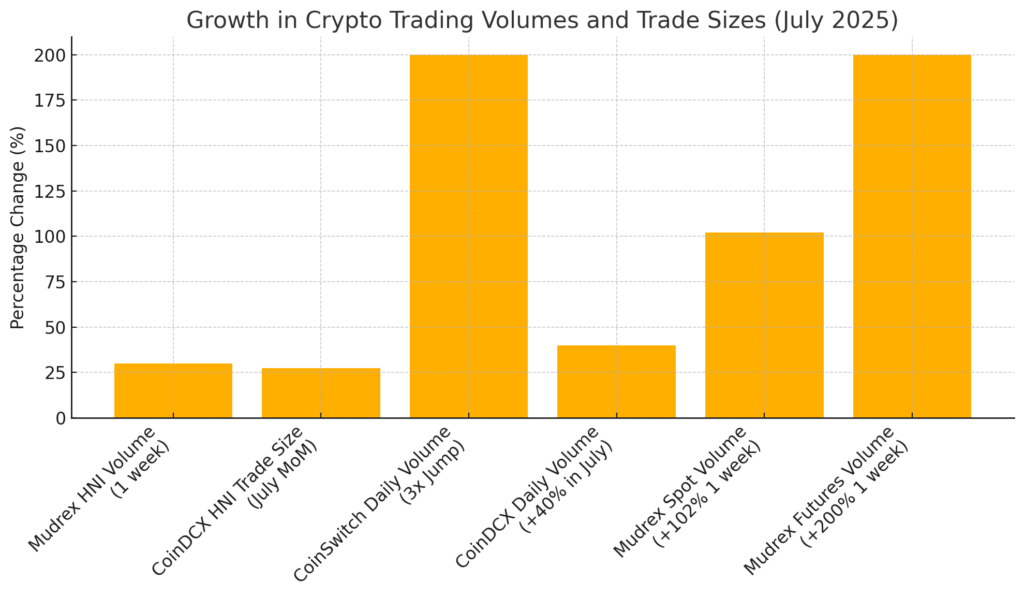
Main Points:
- Significant surge in HNI and family office crypto allocations on leading Indian exchanges
- Macro catalysts: Bitcoin’s record rally, U.S. “Crypto Week,” and global institutional endorsement
- Retail investors driving daily volume spikes, especially in meme coins and blue-chip tokens
- Regulatory and tax uncertainties remain a barrier to broader adoption
- Outlook: Continued growth amid evolving policy landscape and emerging DeFi/business use cases
1. Surge in HNI Crypto Allocations
India’s wealthy investors and family offices have markedly shifted their portfolios toward digital assets, favoring Bitcoin (BTC) and Ethereum (ETH) over traditional instruments like stocks and gold. According to Moneycontrol, Mudrex saw HNI trading volumes rise by 30% in a single week, reaching $10 million (roughly ¥148 million). CoinDCX similarly reported a 25–30% month-on-month increase in average HNI trade size during July, compared to June .
This pivot underscores a broader transition: conversations among HNIs have evolved from “Why crypto?” to “How much, and where, should we invest?” as noted by Ashish Singhal, co-founder of CoinSwitch The growing preference for established cryptocurrencies with proven liquidity and security is driving these allocations, even as interest in Solana (SOL) and Ripple (XRP) gains traction.

Figure 1: Growth in Crypto Trading Volumes and Trade Sizes
Insert chart here illustrating percentage increases across platforms
2. Macro Catalysts Driving the Rally
Several macro factors have converged to fuel this crypto upswing:
- Bitcoin’s record highs: BTC recently surpassed $120,000, outperforming stocks, bonds, and gold with a ~90% year-on-year return.
- U.S. “Crypto Week”: From July 14–18, three pivotal bills—the Genius Act (stablecoin regulation), the Clarity Act (regulatory definitions), and the Anti-CBDC Surveillance State Act—advanced through Congress, culminating in the Genius Act’s signing into law.
- Institutional entry: Global financial giants (e.g., BlackRock, Fidelity) rolling out spot Bitcoin ETFs and custody solutions have bolstered confidence, sending positive signals to HNIs worldwide.
These developments have persuaded affluent Indian investors that digital assets are not a passing fad but a legitimate asset class capable of preserving and growing wealth in volatile markets.
3. Retail Investors Fueling the Momentum
While HNI activity has surged, retail traders are the engine behind daily volume spikes:
- CoinSwitch: Daily trading volumes tripled following Bitcoin’s rally.
- CoinDCX: Daily volumes climbed 40% in July to $12.82 million (approx. ¥1.98 billion).
- Mudrex: Spot trading jumped 102%, and futures trading soared 200% in just one week; over half of this came from meme coins like Dogecoin (DOGE), Pepe (PEPE), and Shiba Inu (SHIB), with the balance in BTC, ETH, SOL, and XRP.
This retail enthusiasm reflects broader investor education efforts and FOMO, as many newcomers chase quick gains. Simultaneously, a subset of investors is profit-taking, indicating a maturing market where traders recognize both upside potential and downside risks.
4. Regulatory and Tax Hurdles
Despite robust growth, India’s regulatory framework poses challenges:
- High taxation: A flat 30% tax on crypto gains—one of the highest slabs in India—deters many potential investors.
- Ambiguous regulations: Lack of clear guidance on custodial requirements, KYC norms, and exchange licensing leads to uncertainty and potential compliance risks.
- Potential Central Bank Digital Currency (CBDC) rollouts may reshape the landscape further, requiring investors to adapt.
Experts advocate for simplified rules, lower tax rates, and a regulatory sandbox to foster innovation while protecting investors. Equally, alignment with global standards—mirroring U.S. and EU regulations—could cement India’s role in the emerging digital asset ecosystem.
5. Looking Ahead: Opportunities and Risks
Opportunities
- DeFi and yield farming: HNIs are exploring decentralized finance platforms for attractive yields, beyond mere spot trading.
- Tokenization of real-world assets: Pilot projects in real estate, art, and commodities could unlock new asset classes for Indian investors.
- Institutional products: Launch of crypto mutual funds, structured products, and derivatives will cater to conservative HNIs seeking diversified exposure.
Risks
- Market volatility: Rapid price swings can erode capital, especially for late entrants.
- Cybersecurity threats: Recent CoinDCX treasury hack of $44 million underscores the need for robust exchange security measures.
- Regulatory clampdown: Sudden policy reversals or bans could trigger market shocks, as seen in past global examples.
Conclusion
India’s wealthy investors are decisively embracing cryptocurrencies, driven by Bitcoin’s blockbuster performance, positive regulatory signals from the U.S., and an evolving institutional landscape. While HNIs lead the charge with sizable allocations, retail traders amplify the momentum through daily volume surges—often chasing high-growth meme coins. Yet, regulatory ambiguity and steep taxes in India remain constraints that could temper future gains. Looking forward, innovations in DeFi, tokenized assets, and institutional product offerings promise new opportunities for diversification and yield. As this ecosystem matures, balancing growth with prudent risk management will be key for Indian investors aiming to harness the full potential of blockchain technology.

